Abstract
We studied biochemical genetics of low density lipoprotein (LDL) receptor mutations in fibroblasts from six homozygous and five heterozygous patients with familial hypercholesterolemia (FH). Three of six homozygotes are receptor-negative type and the other three homozygotes are receptor-defective type. In the cells from three receptor-negative homozygotes, the receptor binding, internalization, and degradation of 125I-LDL were 0.5±0.3 ng/mg protein (mean±SEM), 14±8 and 8±6 ng/mg protein per 6 h (four normal cells; 44±3, 386±32, and 1,335±214 ng/mg protein per 6 h), respectively. In the cells from three receptor-defective homozygotes, the receptor binding, internalization, and degradation of 125I-LDL were 6±2, 29±8, and 90±32 ng/mg protein per 6 h, respectively. In these six homozygotes, two pairs of siblings are included. Two siblings in the same family were classified as receptor-negative and two siblings in another family were classified as receptor-defective. The receptor-negative phenotypes and the receptor-defective phenotypes bred true in individual families. The cells from five heterozygotes showed ∼46% of the normal activities of receptor.
ML-236B, competitive inhibitor of 3-hydroxy-3-methylglutaryl coenzyme A reductase (HMG-CoA reductase), completely inhibited the incorporation of [14C]acetate into digitonin-precipitable sterols in fibroblasts from normal subjects and heterozygous and homozygous patients with FH with the concentration of 0.5 μg/ml. However, at 0.05 μg/ml of ML-236B sterol synthesis in fibroblasts from homozygotes was not completely suppressed in contrast to normal and heterozygous cells. Moreover, after preincubation with 0.05 μg/ml of ML-236B for 24 h in medium containing lipoproteins, sterol synthesis in the cells from receptor-negative homozygote showed 75% of the initial activity compared with that of 25% without preincubation. In the cells from a normal subject and a heterozygote, sterol synthesis was inhibited even after preincubation. These results suggest that (a) the inhibitory effect of ML-236B is overcome in homozygote cells by their high intracellular levels of HMG-CoA reductase and (b) that a higher dose of ML-236B may be required to lower serum cholesterol levels in FH homozygotes than in heterozygotes.
Full text
PDF

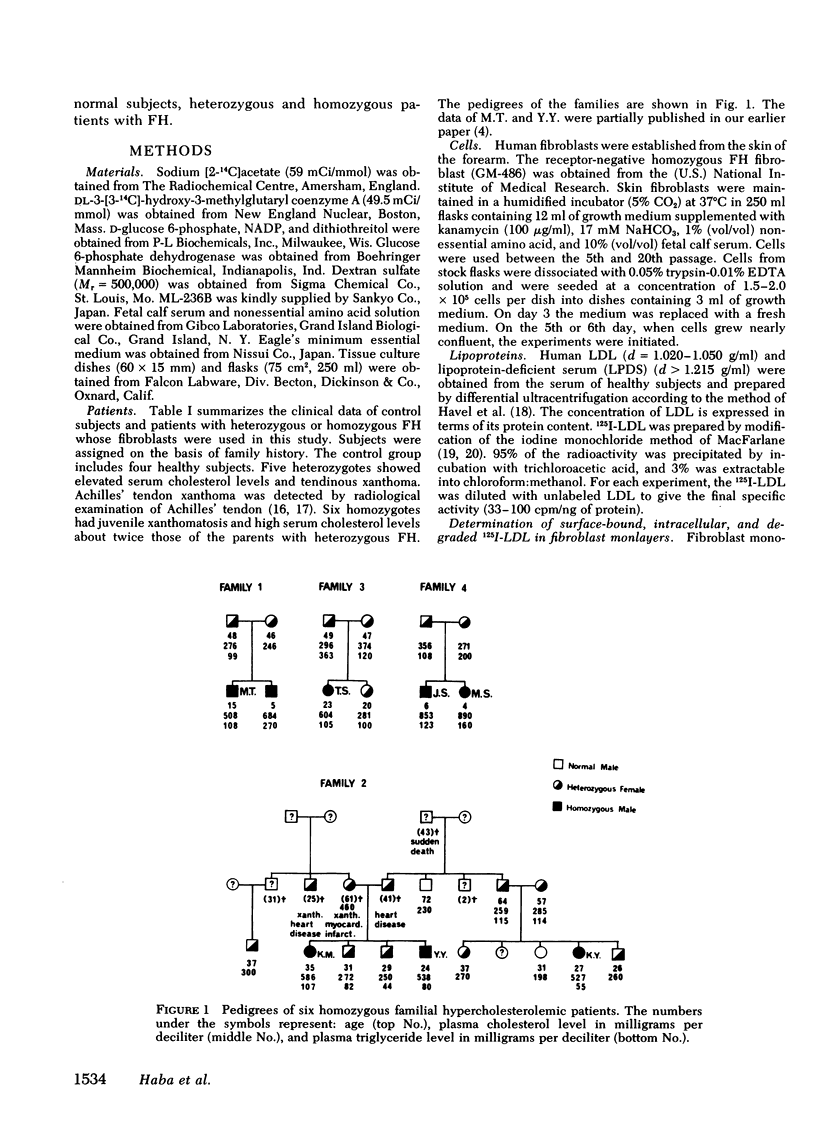
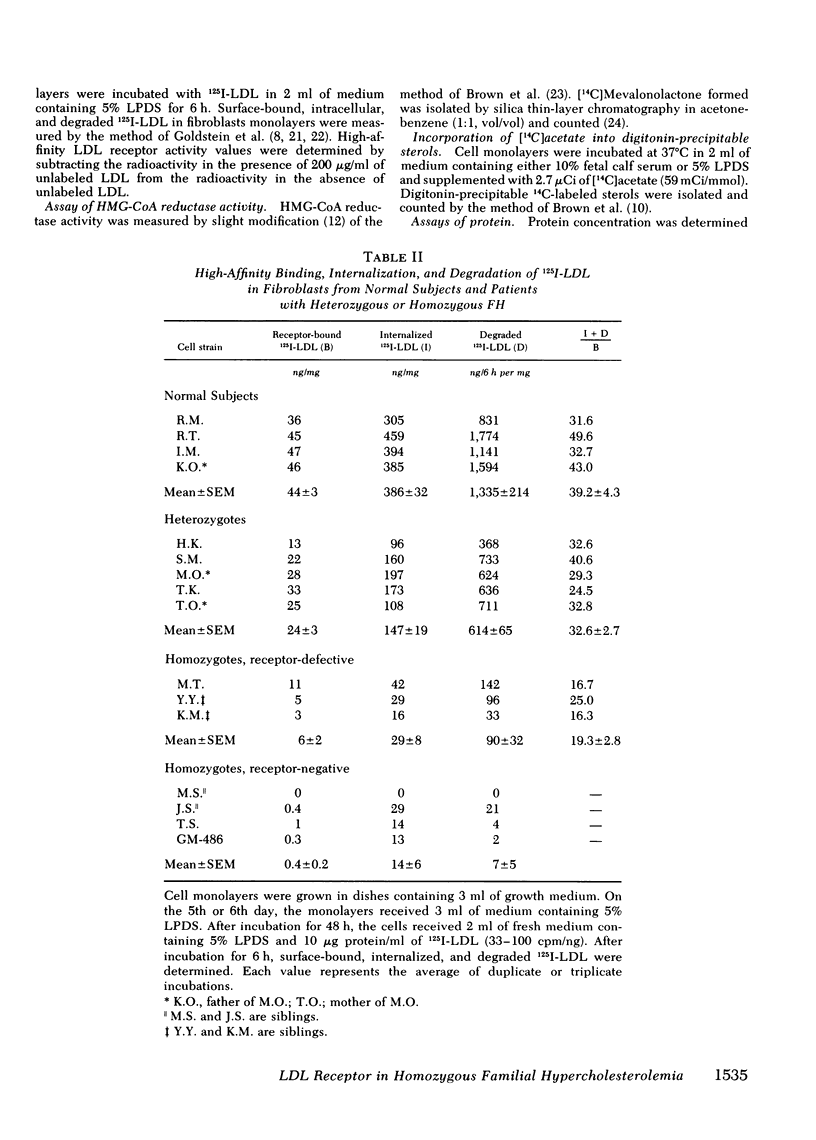
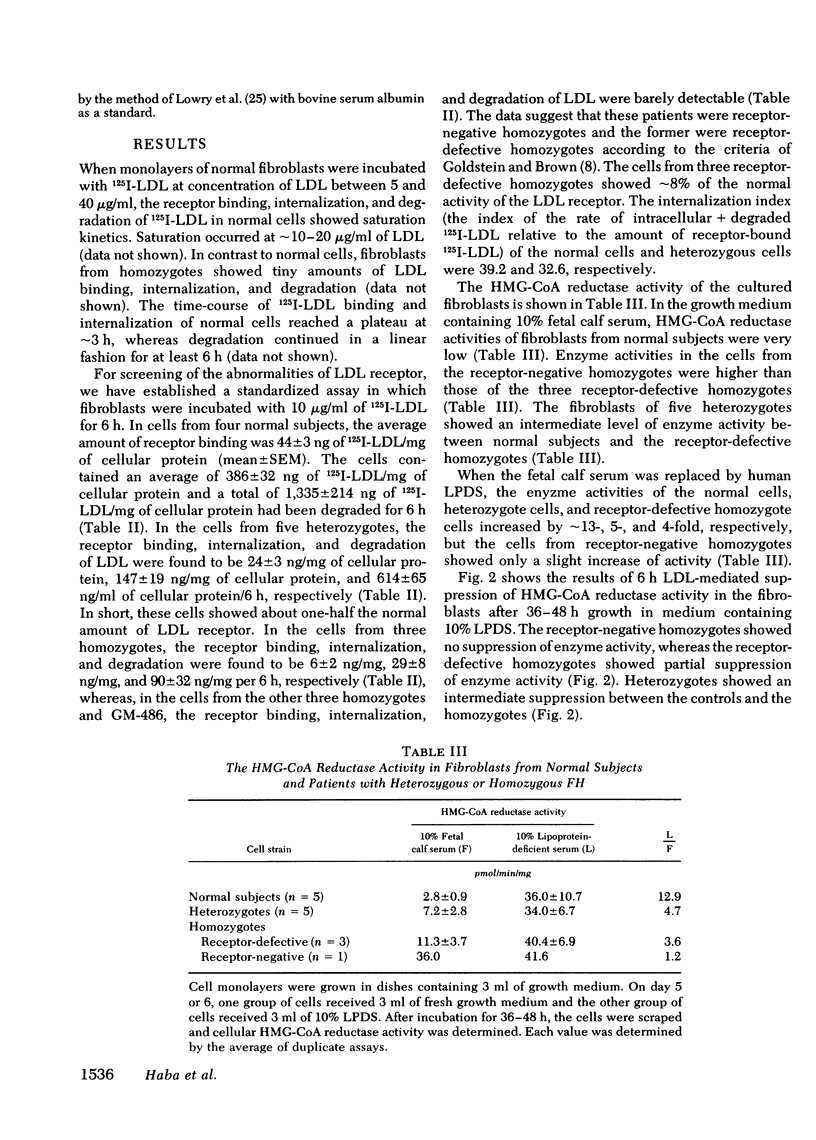
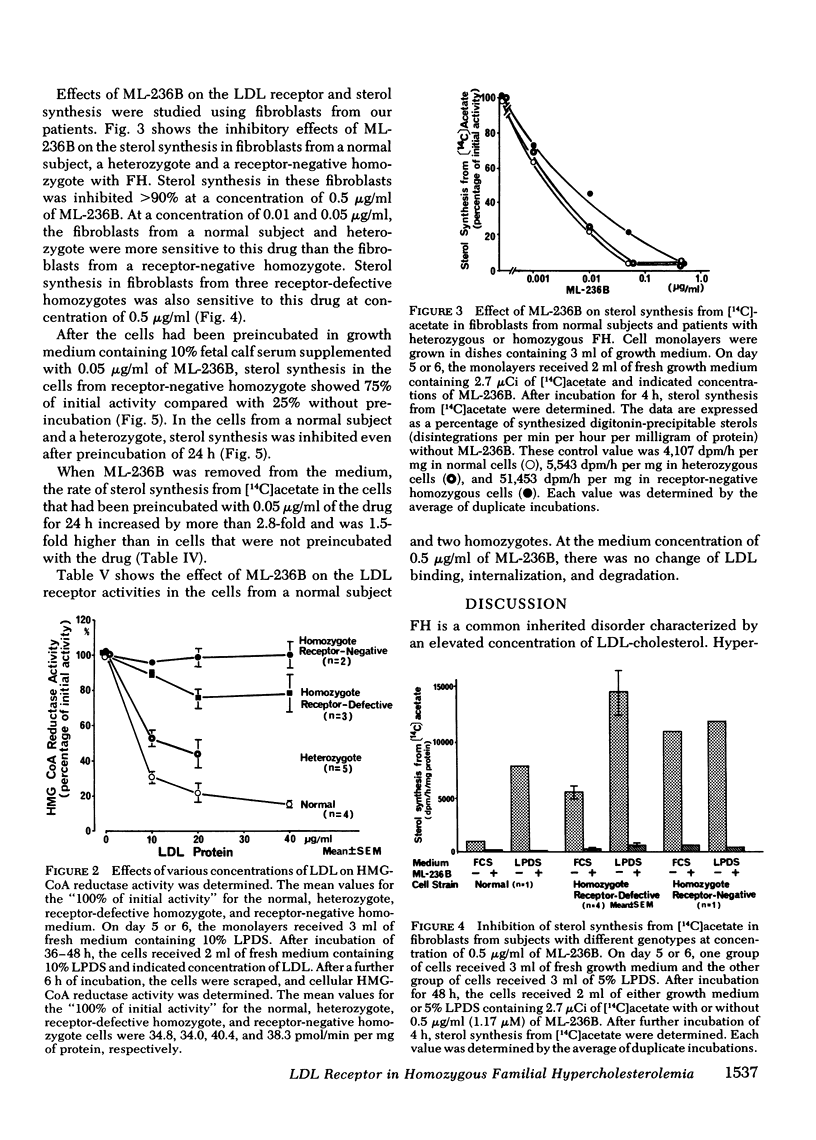
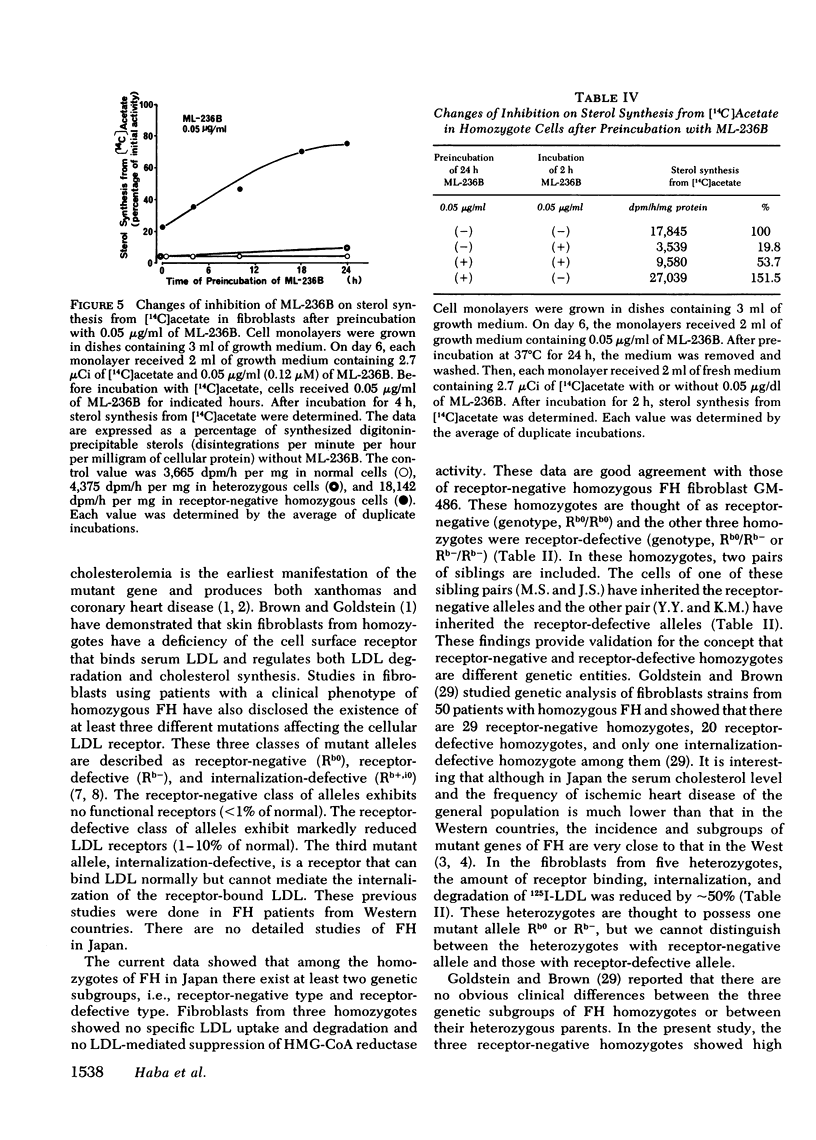
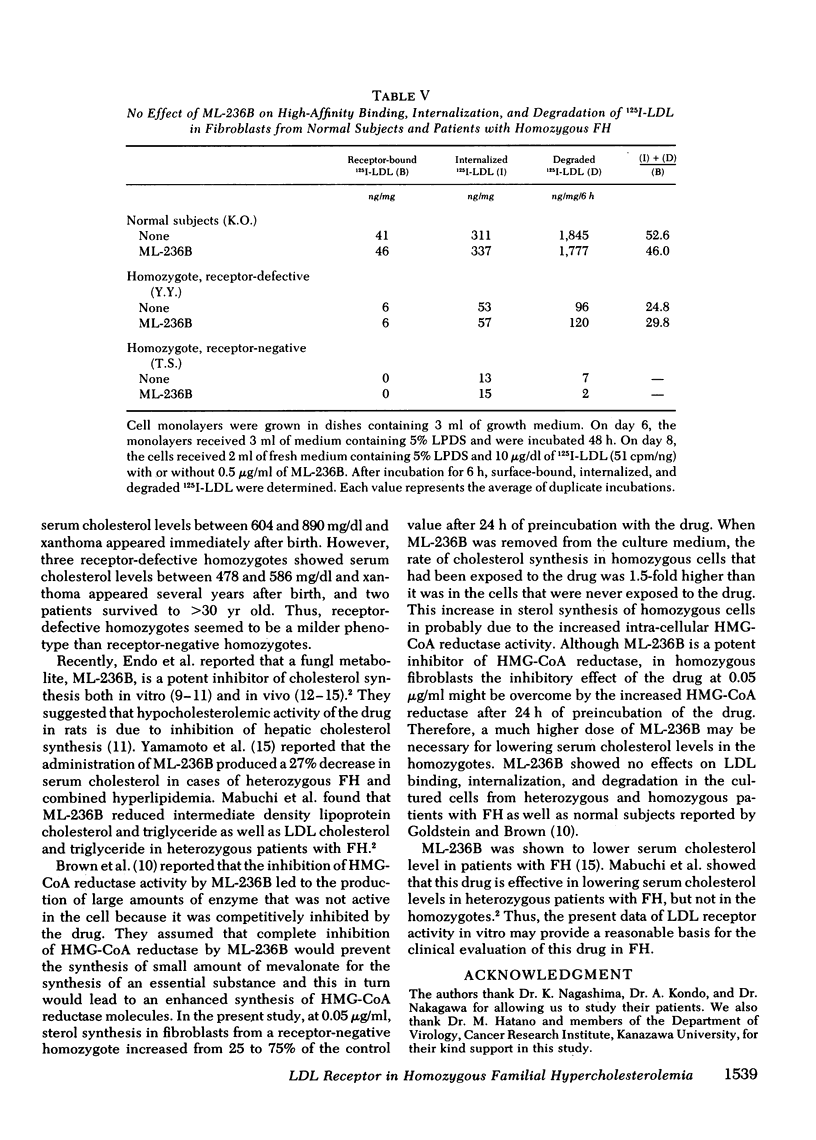
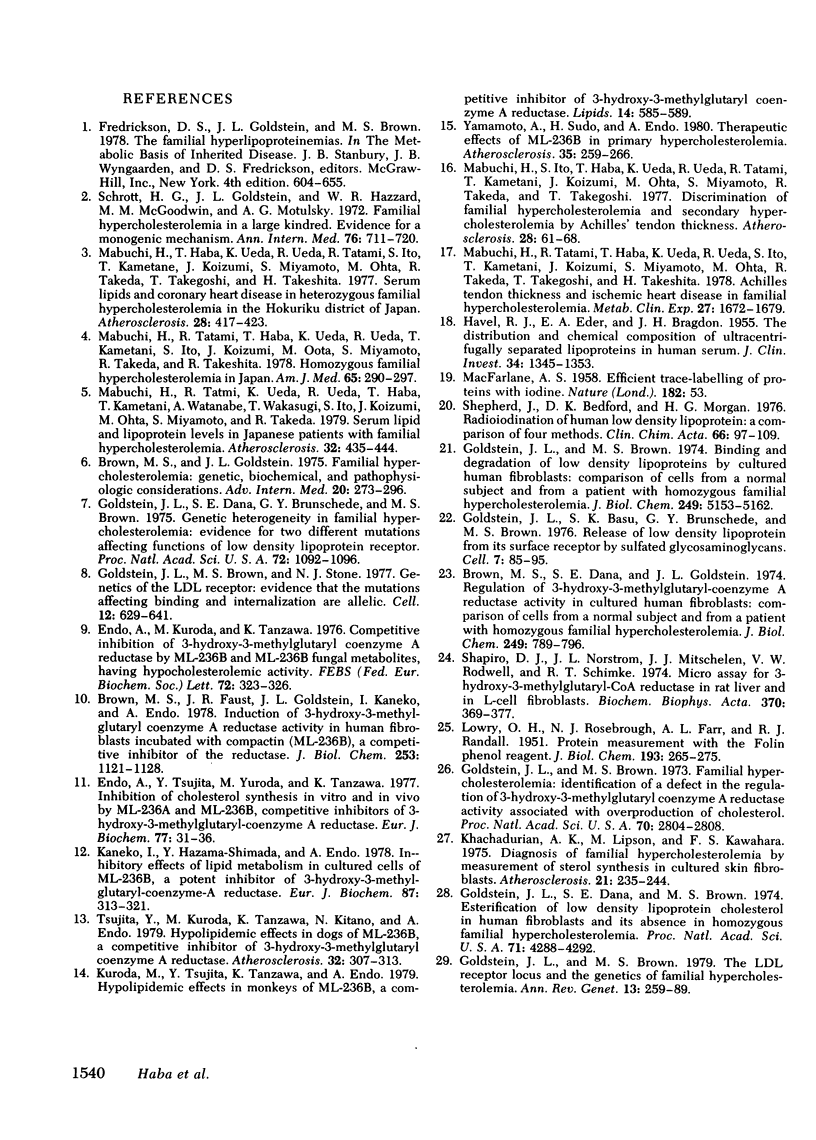
Selected References
These references are in PubMed. This may not be the complete list of references from this article.
- Brown M. S., Dana S. E., Goldstein J. L. Regulation of 3-hydroxy-3-methylglutaryl coenzyme A reductase activity in cultured human fibroblasts. Comparison of cells from a normal subject and from a patient with homozygous familial hypercholesterolemia. J Biol Chem. 1974 Feb 10;249(3):789–796. [PubMed] [Google Scholar]
- Brown M. S., Faust J. R., Goldstein J. L., Kaneko I., Endo A. Induction of 3-hydroxy-3-methylglutaryl coenzyme A reductase activity in human fibroblasts incubated with compactin (ML-236B), a competitive inhibitor of the reductase. J Biol Chem. 1978 Feb 25;253(4):1121–1128. [PubMed] [Google Scholar]
- Brown M. S., Goldstein J. L. Familial hypercholesterolemia: genetic, biochemical and pathophysiologic considerations. Adv Intern Med. 1975;20:273–296. [PubMed] [Google Scholar]
- Endo A., Kuroda M., Tanzawa K. Competitive inhibition of 3-hydroxy-3-methylglutaryl coenzyme A reductase by ML-236A and ML-236B fungal metabolites, having hypocholesterolemic activity. FEBS Lett. 1976 Dec 31;72(2):323–326. doi: 10.1016/0014-5793(76)80996-9. [DOI] [PubMed] [Google Scholar]
- Endo A., Tsujita Y., Kuroda M., Tanzawa K. Inhibition of cholesterol synthesis in vitro and in vivo by ML-236A and ML-236B, competitive inhibitors of 3-hydroxy-3-methylglutaryl-coenzyme A reductase. Eur J Biochem. 1977 Jul 1;77(1):31–36. doi: 10.1111/j.1432-1033.1977.tb11637.x. [DOI] [PubMed] [Google Scholar]
- Goldstein J. L., Basu S. K., Brunschede G. Y., Brown M. S. Release of low density lipoprotein from its cell surface receptor by sulfated glycosaminoglycans. Cell. 1976 Jan;7(1):85–95. doi: 10.1016/0092-8674(76)90258-0. [DOI] [PubMed] [Google Scholar]
- Goldstein J. L., Brown M. S. Binding and degradation of low density lipoproteins by cultured human fibroblasts. Comparison of cells from a normal subject and from a patient with homozygous familial hypercholesterolemia. J Biol Chem. 1974 Aug 25;249(16):5153–5162. [PubMed] [Google Scholar]
- Goldstein J. L., Brown M. S. Familial hypercholesterolemia: identification of a defect in the regulation of 3-hydroxy-3-methylglutaryl coenzyme A reductase activity associated with overproduction of cholesterol. Proc Natl Acad Sci U S A. 1973 Oct;70(10):2804–2808. doi: 10.1073/pnas.70.10.2804. [DOI] [PMC free article] [PubMed] [Google Scholar]
- Goldstein J. L., Brown M. S., Stone N. J. Genetics of the LDL receptor: evidence that the mutations affecting binding and internalization are allelic. Cell. 1977 Nov;12(3):629–641. doi: 10.1016/0092-8674(77)90263-x. [DOI] [PubMed] [Google Scholar]
- Goldstein J. L., Brown M. S. The LDL receptor locus and the genetics of familial hypercholesterolemia. Annu Rev Genet. 1979;13:259–289. doi: 10.1146/annurev.ge.13.120179.001355. [DOI] [PubMed] [Google Scholar]
- Goldstein J. L., Dana S. E., Brown M. S. Esterification of low density lipoprotein cholesterol in human fibroblasts and its absence in homozygous familial hypercholesterolemia. Proc Natl Acad Sci U S A. 1974 Nov;71(11):4288–4292. doi: 10.1073/pnas.71.11.4288. [DOI] [PMC free article] [PubMed] [Google Scholar]
- Goldstein J. L., Dana S. E., Brunschede G. Y., Brown M. S. Genetic heterogeneity in familial hypercholesterolemia: evidence for two different mutations affecting functions of low-density lipoprotein receptor. Proc Natl Acad Sci U S A. 1975 Mar;72(3):1092–1096. doi: 10.1073/pnas.72.3.1092. [DOI] [PMC free article] [PubMed] [Google Scholar]
- HAVEL R. J., EDER H. A., BRAGDON J. H. The distribution and chemical composition of ultracentrifugally separated lipoproteins in human serum. J Clin Invest. 1955 Sep;34(9):1345–1353. doi: 10.1172/JCI103182. [DOI] [PMC free article] [PubMed] [Google Scholar]
- Kaneko I., Hazama-Shimada Y., Endo A. Inhibitory effects on lipid metabolism in cultured cells of ML-236B, a potent inhibitor of 3-hydroxy-3-methylglutaryl-coenzyme-A reductase. Eur J Biochem. 1978 Jun 15;87(2):313–321. doi: 10.1111/j.1432-1033.1978.tb12380.x. [DOI] [PubMed] [Google Scholar]
- Khachadurian A. K., Lipson M., Kawahara F. S. Diagnosis of familial hypercholesterolemia by measurement of sterol synthesis in cultured skin fibroblasts. Atherosclerosis. 1975 Mar-Apr;21(2):235–244. doi: 10.1016/0021-9150(75)90083-0. [DOI] [PubMed] [Google Scholar]
- Kuroda M., Tsujita Y., Tanzawa K., Endo A. Hypolipidemic effects in monkeys of ML-236B, a competitive inhibitor of 3-hydroxy-3-methylglutaryl coenzyme A reductase. Lipids. 1979 Jun;14(6):585–589. doi: 10.1007/BF02533537. [DOI] [PubMed] [Google Scholar]
- LOWRY O. H., ROSEBROUGH N. J., FARR A. L., RANDALL R. J. Protein measurement with the Folin phenol reagent. J Biol Chem. 1951 Nov;193(1):265–275. [PubMed] [Google Scholar]
- Mabuchi H., Haba T., Ueda K., Ueda R., Tatami R., Ito S., Kametani T., Koizumi J., Miyamoto S., Ohta M. Serum lipids and coronary heart disease in heterozygous familial hypercholesterolemia in the Hokuriku District of Japan. Atherosclerosis. 1977 Dec;28(4):417–423. doi: 10.1016/0021-9150(77)90068-5. [DOI] [PubMed] [Google Scholar]
- Mabuchi H., Ito S., Haba T., Ueda K., Ueda R. Discrimination of familial hypercholesterolemia and secondary hypercholesterolemia by Achilles' tendon thickness. Atherosclerosis. 1977 Sep;28(1):61–68. doi: 10.1016/0021-9150(77)90199-x. [DOI] [PubMed] [Google Scholar]
- Mabuchi H., Tatami R., Haba T., Ueda K., Ueda R., Ito S., Karnetani T., Koizurni J., Miyamoto S., Ohta M. Achilles tendon thickness and ischemic heart disease in familial hypercholesterolemia. Metabolism. 1978 Nov;27(11):1672–1679. doi: 10.1016/0026-0495(78)90289-5. [DOI] [PubMed] [Google Scholar]
- Mabuchi H., Tatami R., Haba T., Ueda K., Ueda R., Kametani T., Itoh S., Koizumi J., Oota M., Miyamoto S. Homozygous familial hypercholesterolemia in Japan. Am J Med. 1978 Aug;65(2):290–297. doi: 10.1016/0002-9343(78)90822-7. [DOI] [PubMed] [Google Scholar]
- Mabuchi H., Tatami R., Ueda K., Ueda R., Haba T., Kametani T., Watanabe A., Wakasugi T., Ito S., Koizumi J. Serum lipid and lipoprotein levels in Japanese patients with familial hypercholesterolemia. Atherosclerosis. 1979 Apr;32(4):435–444. doi: 10.1016/0021-9150(79)90009-1. [DOI] [PubMed] [Google Scholar]
- Schrott H. G., Goldstein J. L., Hazzard W. R., McGoodwin M. M., Motulsky A. G. Familial hypercholesterolemia in a large indred. Evidence for a monogenic mechanism. Ann Intern Med. 1972 May;76(5):711–720. doi: 10.7326/0003-4819-76-5-711. [DOI] [PubMed] [Google Scholar]
- Shapiro D. J., Nordstrom J. L., Mitschelen J. J., Rodwell V. W., Schimke R. T. Micro assay for 3-hydroxy-3-methylglutaryl-CoA reductase in rat liver and in L-cell fibroblasts. Biochim Biophys Acta. 1974 Dec 29;370(2):369–377. doi: 10.1016/0005-2744(74)90098-9. [DOI] [PubMed] [Google Scholar]
- Shepherd J., Bedford D. K., Morgan H. G. Radioiodination of human low density lipoprotein: a comparison of four methods. Clin Chim Acta. 1976 Jan 2;66(1):97–109. doi: 10.1016/0009-8981(76)90376-4. [DOI] [PubMed] [Google Scholar]
- Tsujita Y., Kuroda M., Tanzawa K., Kitano N., Endo A. Hypolipidemic effects in dogs of ML-236B, a competitive inhibitor of 3-hydroxy-3-methylglutaryl coenzyme A reductase. Atherosclerosis. 1979 Mar;32(3):307–313. doi: 10.1016/0021-9150(79)90174-6. [DOI] [PubMed] [Google Scholar]
- Yamamoto A., Sudo H., Endo A. Therapeutic effects of ML-236B in primary hypercholesterolemia. Atherosclerosis. 1980 Mar;35(3):259–266. doi: 10.1016/0021-9150(80)90124-0. [DOI] [PubMed] [Google Scholar]


